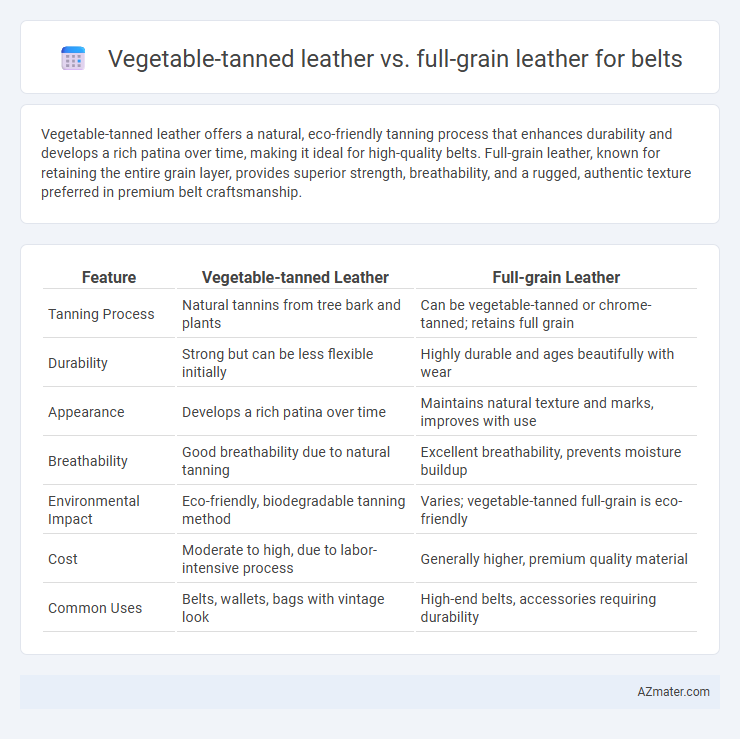Vegetable-tanned leather offers a natural, eco-friendly tanning process that enhances durability and develops a rich patina over time, making it ideal for high-quality belts. Full-grain leather, known for retaining the entire grain layer, provides superior strength, breathability, and a rugged, authentic texture preferred in premium belt craftsmanship.
Table of Comparison
| Feature | Vegetable-tanned Leather | Full-grain Leather |
|---|---|---|
| Tanning Process | Natural tannins from tree bark and plants | Can be vegetable-tanned or chrome-tanned; retains full grain |
| Durability | Strong but can be less flexible initially | Highly durable and ages beautifully with wear |
| Appearance | Develops a rich patina over time | Maintains natural texture and marks, improves with use |
| Breathability | Good breathability due to natural tanning | Excellent breathability, prevents moisture buildup |
| Environmental Impact | Eco-friendly, biodegradable tanning method | Varies; vegetable-tanned full-grain is eco-friendly |
| Cost | Moderate to high, due to labor-intensive process | Generally higher, premium quality material |
| Common Uses | Belts, wallets, bags with vintage look | High-end belts, accessories requiring durability |
Introduction: Understanding Leather Types for Belts
Vegetable-tanned leather and full-grain leather represent two premium types of leather commonly used in high-quality belts. Vegetable tanning involves using natural tannins from tree bark and plants, resulting in leather that develops a rich patina over time and offers enhanced durability. Full-grain leather, prized for retaining the natural grain layer, provides superior strength, breathability, and a unique, rugged appearance that improves with wear.
What is Vegetable-Tanned Leather?
Vegetable-tanned leather is a type of leather cured using natural tannins found in tree bark, leaves, and other plant materials, resulting in a durable and eco-friendly product. This tanning process preserves the leather's natural fiber structure, offering a firm yet flexible texture ideal for belts that develop a unique patina over time. In contrast to chrome-tanned leather, vegetable-tanned leather tends to be stiffer initially but ages gracefully, making it a preferred choice for high-quality full-grain leather belts.
What is Full-Grain Leather?
Full-grain leather is the highest quality leather available, made from the top layer of the animal hide that includes all of the grain and natural markings, ensuring maximum durability and breathability. It develops a rich patina over time, enhancing its aesthetic value and character, making it a popular choice for premium belts. Unlike vegetable-tanned leather, which is tanned using natural tannins from plants, full-grain leather can undergo various tanning processes but retains its natural surface, offering superior strength and longevity.
Durability: Vegetable-Tanned vs Full-Grain Leather
Full-grain leather offers superior durability due to its intact natural grain, making it more resistant to wear and tear compared to vegetable-tanned leather. Vegetable-tanned leather, while durable and environmentally friendly, tends to develop a softer patina over time but may be more prone to scratches and scuffs. For belts requiring long-lasting strength and resilience, full-grain leather remains the optimal choice.
Aesthetic Appeal: Surface Texture and Patina
Vegetable-tanned leather belts showcase a rich, natural texture that deepens and develops a unique patina over time, enhancing their aesthetic appeal with age and wear. Full-grain leather belts retain the hide's original surface, including natural imperfections and grain patterns, providing a robust, luxurious look that improves with use. Both types offer distinctive visual qualities, but vegetable-tanned leather tends to develop warmer tones and a more characterful aging process compared to the uniform durability of full-grain leather.
Comfort and Flexibility in Everyday Use
Vegetable-tanned leather offers a natural, supple feel that softens over time, enhancing comfort and flexibility for everyday belt wear. Full-grain leather, known for its durability and resistance, initially feels stiffer but gradually molds to the body, providing personalized comfort with prolonged use. Both leathers improve in pliability with use, but vegetable-tanned leather generally requires less break-in time for a flexible, comfortable belt experience.
Environmental Impact and Sustainability
Vegetable-tanned leather for belts uses natural tannins from plant materials, reducing chemical pollutants and minimizing environmental harm compared to chromium-tanned processes often used in full-grain leather production. Full-grain leather, prized for durability and natural surface, typically involves more intensive processing and higher chemical usage, which can increase its ecological footprint. Choosing vegetable-tanned full-grain leather combines sustainability with premium quality, offering a more eco-friendly option that supports leather longevity and reduces waste.
Price Comparison: Value for Money
Vegetable-tanned leather belts typically cost more due to the time-intensive natural tanning process but offer superior durability and develop a rich patina, providing excellent long-term value. Full-grain leather belts may have a slightly lower initial price but can lack the unique aging qualities and eco-friendly aspects of vegetable tanning. Investing in vegetable-tanned leather often delivers better value for money through enhanced longevity and character over time.
Maintenance and Aging Characteristics
Vegetable-tanned leather develops a rich patina over time, requiring regular conditioning to prevent drying and cracking, while full-grain leather is naturally more durable and ages gracefully with minimal maintenance. Both types benefit from occasional cleaning and moisturizing, but vegetable-tanned leather is more sensitive to moisture and temperature changes, necessitating careful care to preserve its quality. Full-grain leather resists stains and scuffs better, making it ideal for belts that seek longevity with a rugged, natural appearance.
Choosing the Right Leather for Your Next Belt
Vegetable-tanned leather and full-grain leather both offer durability and natural aging qualities ideal for belts, but vegetable-tanned leather is crafted using natural tannins that provide a firmer texture and develops a rich patina over time. Full-grain leather, known for retaining the entire grain layer, offers superior strength, breathability, and a more rugged, authentic look that enhances with wear. Choosing the right leather depends on your preference for texture and aging process: vegetable-tanned belts suit those seeking a refined, classic appearance, while full-grain belts appeal to individuals prioritizing durability and a natural, rustic finish.

Infographic: Vegetable-tanned leather vs Full-grain leather for Belt
 azmater.com
azmater.com